Guttigadus globosus, the tadpole cod, is a deepwater fish found in the oceanic islands off New Zealand and in the mid South Atlantic at depths ranging from 1200 to 1600 m.
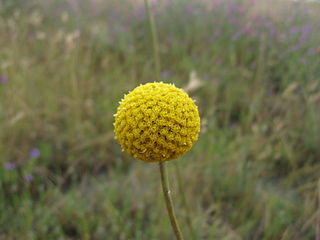
Pycnosorus is a genus of six species of plants in the family Asteraceae. Commonly known as billy buttons or drumsticks, they are annual or perennial herbs or small shrubs with a cylindrical to spherical head of up to 200 daisy-like "flowers". Each "flower" is a pseudanthium consisting of between three and eight florets surrounded by bracts. The petals are joined to form a small tube and the florets with their surrounding bracts are yellow or golden-yellow.
Dipterocarpus globosus is a species of tree in the family Dipterocarpaceae endemic to Borneo, where it occurs in Brunei, Sarawak (Malaysia) and Kalimantan (Indonesia).
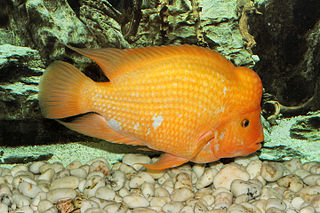
Amphilophus citrinellus is a large cichlid fish endemic to the San Juan River and adjacent watersheds in Costa Rica and Nicaragua. In the aquarium trade A. citrinellus is often sold under the trade name of Midas cichlid. A. citrinellus are omnivorous and their diet consists of plant material, molluscs and smaller fish. The species is closely related to, but not to be mistaken for, Amphilophus labiatus, which shares the nickname red devil cichlid.
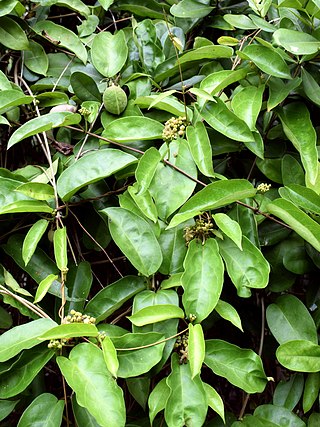
Sarcolobus globosus is a twining shrub native to tropical regions of Asia including India, China, Thailand, Malaysia, Myanmar-Burma, the Philippines and Indonesia.
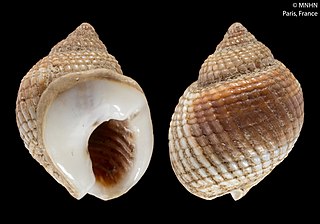
Nassarius globosus, common name the globose nassa, is a species of sea snail, a marine gastropod mollusc in the family Nassariidae, the Nassa mud snails or dog whelks.
Phyllonotus globosus, common name : the globular apple murex, is a species of sea snail, a marine gastropod mollusc in the family Muricidae, the murex snails or rock snails.
Proprioseiopsis globosus is a species of mite in the family Phytoseiidae.

Bulinus globosus is a species of a tropical freshwater snail with a sinistral shell, an aquatic gastropod mollusk in the family Planorbidae, the ramshorn snails and their allies.
Nelomites is genus of ammonoid cephalopods belonging to the Cheiloceratidae family. Species belonging to this genus lived in late Devonian (Famennian). This genus was originally described under the name MelonitesBogoslovskii, 1971; however, the same generic name has also been used for genus of echinoid named MelonitesNorwood & Owen, 1846. Bockwinkel, Korn & Herd (2019) coined a replacement generic name Nelomites.
Caelostomus globosus is a species of ground beetle in the subfamily Pterostichinae. It was described by Jeannel in 1948.

Dyschirius globosus is a species of ground beetle in the subfamily Scaritinae. It was described by Herbst in 1784.
Microdon globosus is a species of syrphid fly in the family Syrphidae.
Neoxenus is a genus of fungus weevils in the beetle family Anthribidae. There are about six described species in Neoxenus.

Stenotarsus is a genus of handsome fungus beetles in the family Endomychidae. There are more than 50 described species in Stenotarsus.
Dendrosinus is a genus of crenulate bark beetles in the family Curculionidae. There are about 12 described species in Dendrosinus.
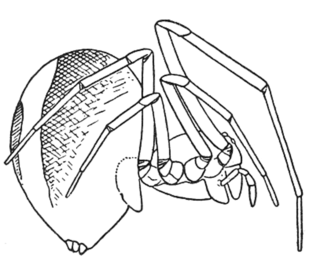
Hentziectypus globosus is a species of cobweb spider in the family Theridiidae. It is found in North America.
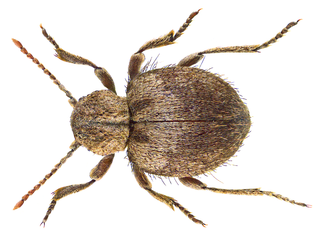
Trigonogenius globulum, the globular spider beetle, is a species of spider beetle in the family Ptinidae. It is found in Africa, Australia, Europe and Northern Asia, North America, and South America. The species name has been frequently misspelled as globulus.
Hesperochernes is a genus of pseudoscorpions in the family of Chernetidae.
Canopus is a genus of Neotropical bugs with about six species that form the family Canopidae. Bugs in the family Canopidae are small and have a convex lady-bird beetle like shape and are thought to be fungus feeders. The scutellum completely covers the abdomen and wings. The antennae are five segmented.









